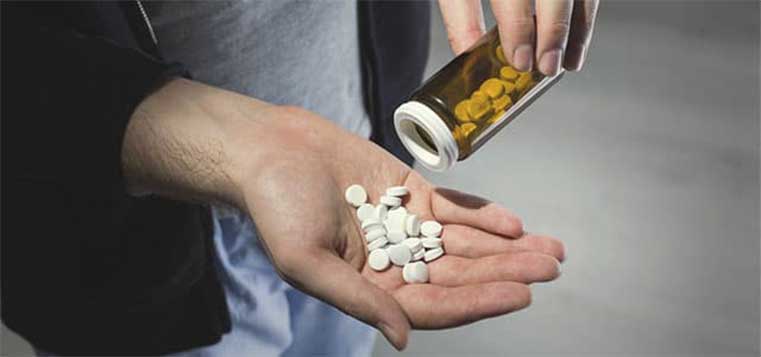Oxycodone Overdose | Signs, Risk Factors, & Treatment

Medically Reviewed By: Kimberly Langdon, M.D.

Oxycodone is a powerful semisynthetic opiate/opioid drug used in a variety of brand-name prescription pain relief medications, including:
- Percocet (oxycodone and acetaminophen)
- Percodan (oxycodone and aspirin)
- OxyContin (controlled release oxycodone)
- OxyIR (immediate release oxycodone)
- OxyFast (Immediate release oxycodone)
While oxycodone has the ability to manage severe pain and chronic pain, its widespread abuse is cited as the primary factor behind the first wave of the opioid overdose epidemic.
This prescription drug continues to sometimes be diverted and abused, despite substantial changes in opioid prescribing and distribution in the medical system.
Oxycodone Overdose
An overdose occurs whenever a person takes an excessive dose of any drug, leading to distressing, harmful, or even life-threatening consequences.
In the case of highly-potent opioid drugs like oxycodone, high doses can be extremely lethal. But they can also trigger an extremely-addictive and long-lasting euphoria.
This is true both of prescription opioids like hydrocodone, fentanyl, and oxymorphone, and heroin or illicit synthetic opioids which are increasingly being smuggled into the country.
At therapeutic doses these drugs interact with opioid receptors located in the brain and elsewhere in the nervous system. This changes how the body responds to pain and stress, helping to keep a person calm and comfortable.
At higher doses, however, opioids act as dangerous central nervous system depressants and can overwhelm a person’s vital life functions, especially their ability to think, react, and breathe.
Signs & Symptoms Of Oxycodone Overdose
Medical experts are trained in how to react to a variety of different drug overdoses, whether the overdose was caused by a stimulant, narcotic, alcohol, or another drug or combination of drugs.
These different types of overdoses can be distinguished from one another by the specific signs and symptoms the victim displays. Oxycodone abuse, specifically, will likely cause a variety of distinctive effects, including:
- severe drowsiness
- loss of coordination and muscle control
- mental confusion
- nausea and vomiting
- slow or shallow breathing (respiratory depression)
- cold, clammy skin
- fingernails or lips turning blue/purple
- slow or unsteady heart rate
- low blood pressure
- constricted/pinpoint pupils
- seizures
- unconsciousness/inability to awaken the victim
- choking sounds or a gurgling/snoring noise (the opioid “death rattle”)
Immediately call for professional medical help if you or someone around you begins experiencing any of these symptoms in response to using opioid painkillers,
Risk Factors For Oxycodone Overdose
Anyone who uses opioid analgesics that were not prescribed to them, or who misuses them in other ways, is at risk of overdose. However, there are a variety of risk factors that can put you at a much higher risk of suffering an overdose death, including:
- taking oxycodone in other ways, including through injection, snorting, or smoking
- returning to opioid abuse after a period of not using opioid pain medications, or using lower doses
- suddenly increasing your dosage or switching to a more-potent opioid (including illicit fentanyl, which is sometimes used to fake oxycodone pills)
- taking oxycodone with other depressants like alcohol, benzodiazepines, and muscle relaxants
- taking oxycodone with stimulant drugs like methamphetamine and cocaine
- being in poor overall health
- surviving a past overdose
Responding To An Oxycodone Overdose
Oxycodone overdoses should be treated as a critical medical emergency. Delaying care only leads to an increased risk of death, permanent brain damage, or other physical or mental harms.
If you suspect an overdose has occurred, you should:
- summon emergency medical attention
- administer the opioid antidote naloxone (Narcan) if you have access to it
- stay with the victim, monitoring their condition and placing them on their side in the recovery position
- use an AED (automatic external defibrillator) and/or administer CPR if the victim stops breathing
Once medical staff respond they will take over treatment and transport the victim to a medical setting for advanced care, which may include additional naloxone doses, activated charcoal, laxatives, fluids, breathing support, or resuscitation.
Preventing Oxycodone Overdose
Naloxone is safe, easy to administer, and highly effective at reversing opioid overdose symptoms. It is available over the counter, carried by first responders, and stocked in a wide variety of public spaces.
But while naloxone can save lives, the best way to avoid overdose and other long-term mental and physical side effects of opioid drug abuse is to access professional treatment for opioid use disorder in an inpatient or outpatient setting.
Opioid Addiction Treatment
Your treatment will generally begin with medical detoxification, a professional service designed to help you work through any withdrawal symptoms you may experience as your substance abuse ends. Then you are free to advance to other personalized treatment options including:
- medication-assisted treatment using methadone, buprenorphine, or naltrexone
- individual or group counseling
- psychotherapies, especially cognitive behavioral therapy
- peer support groups
- alternative therapies
- aftercare programs and support
To learn about our inpatient treatment options for substance use disorder, please contact us today.
- Centers For Disease Control And Prevention (CDC) — Understanding the Epidemic https://www.cdc.gov/drugoverdose/epidemic/index.html
- Drug Enforcement Administration (DEA) — OXYCODONE (Trade Names: Tylox®, Percodan®, OxyContin®) https://www.deadiversion.usdoj.gov/drug_chem_info/oxycodone/oxycodone.pdf
- Food and Drug Administration (FDA) — Medication Guide OXYCONTIN® (ox-e-KON-tin) (oxycodone hydrochloride) extended-release tablets, CII https://www.accessdata.fda.gov/drugsatfda_docs/label/2021/022272s047lbl.pdf#page=48
- Substance Abuse And Mental Health Services Administration (SAMHSA) — SAMHSA Opioid Overdose Toolkit https://store.samhsa.gov/sites/default/files/d7/priv/sma18-4742.pdf

